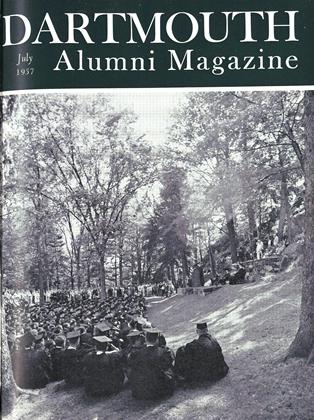. By Evan Connell Jr. '45. NewYork: The Viking Press, Inc. 1957. 214 pp.$3.50.
Any reader of this book will most likely be attracted by Connell's picture on the dust jacket. The concentration of his gaze intensifies his whole face. Are these eyes searching for the very secret of some object beyond the frame of the picture, or do they catch mirrorlike the object's impression? The author himself tells us, not in this collection of stories but in a biographical squib for The Best American Short Stories, 1955, "My primary interest has always been in the graphic arts." We may assume, therefore,, that Connell concerns himself with the appearance of things.
In fact, the subject matter of his stories bears out his statement. He selects the unusual, the disparity, the incongruous: the expatriot who returns to visit his old Kansas school friends, the ballerina who shaves back her hairline, bald Tony Minula in a raincoat and gaudy pajamas who sits on the floor cutting pictures from magazines, a black Mexican who delivers a song in shrill screams in a restaurant after his evening meals. Occasionally Connell turns the incongruous impression into a story suggesting the unpredictability and even the mystery of human life; see "The Fisherman from Chihuahua." Just as often the unusual remains nothing but an oddity; see "The Condor and the Guests." In this story J. D. Botkin ships a condor from Peru and chains it to the magnolia tree in his back yard. Our author is happy describing the situation as such, but he fumbles in the attempt to give it significance.
Those stories which achieve an evocative quality sound at times as if other voices were telling them. A writer who refuses to shape events to his own pattern of significance but presents the events to speak for themselves may discover to his dismay that the events are talking - talking, that is, from a readymade point of view. Can you hear Carson McCullers or Flannery O'Connor behind "The Color of the World" and "I Came from Yonder Mountain"? In the stories of social criticism when Connell places the foreign art teacher or the world traveler against the provincial manners of the Kansan, you may hear echoes of the twenties when many writers shared the point of view made fashionable by Sinclair Lewis' exposure of Sauk Center.
But don't mistake me. Evan S. Connell has a talent. With it he catches the peculiar streak of the tulip and presents it in undiminished vividness to the reader. When he allows his deepest convictions to select the particular impression, when he unites that acute outward gaze with an inward vision, he will fashion stories to rank among the best.
 View Full Issue
View Full Issue
More From This Issue
-
 Feature
FeatureHopkins Center and Dartmouth Hall
July 1957 By CHURCHILL P. LATHROP -
 Feature
FeatureThe Commencement Address
July 1957 By DOUGLAS HORTON, D.D. '57 -
 Feature
FeatureThe Fifty-Year Address
July 1957 By JAMES M. O'NEILL '07 -
 Feature
FeatureThe Seniors' Valedictory
July 1957 By LLOYD L. WEINREB '57 -
 Feature
FeatureThe Honorary Degree Citations
July 1957 -
 Feature
FeatureThe 1957 Commencement
July 1957 By GEORGE O'CONNELL
Books
-
 Books
BooksALUMNI PUBLICATIONS
March, 1922 -
 Books
BooksTHE UNIONS.
FEBRUARY 1973 By ARDEN BUCHOLZ '58 -
 Books
BooksHEAR BETTER.
June 1937 By E. H. Carleton, M.D. -
 Books
BooksLABOR IN SHIPYARDS IN THE UNITED STATES
March 1940 By Francis R. Drury '26 -
 Books
BooksBUSINESS IN THE GILDED AGE: THE CONSERVATIVES' BALANCE SHEET
July 1952 By L. G. Hines -
 Books
BooksTHE OTHER KINGDOM,
February 1948 By Vernon Hall JR.


